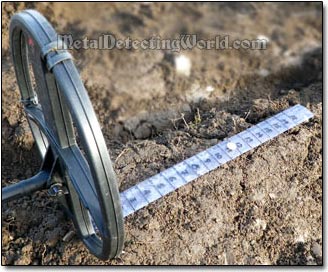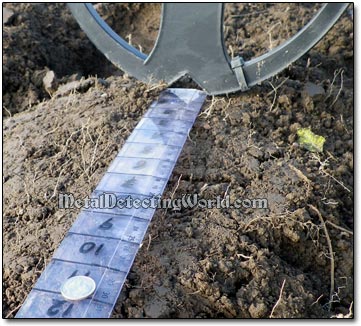How to Air Test (Bench Test) Various Non-Ferrous and Ferrous Targets, p. 1
Learn Your Metal Detector's Depth Potential, Audio and Visual Responses to Targets
by Sergei Upstateny
proficiency level: Expert, date published: ; last time modified:

Generally, Air Test (Bench Test) is a test to determine the maximum sensitivity of your metal detector to various targets that are manually passed across a search coil under IDEAL conditions, i.e. there is nothing but air between the search coil and the targets.
Setting up your Air Test and starting learning your metal detector's language through simple testing procedures is the first thing that you MUST do after reading and re-reading the User Instruction Manual as many times as necessary to understand your detector's capabilities.
Do not even think about taking the metal detector outside and starting metal detecting right away unless you need a good doze of frustration and self-pity. There are certain times for certain things, and as many of us - weathered treasure hunters, learned it back in the day, the smaller steps you take "hiking up" a steep learning curve, the more successful you will be after you get on top of it.
Through Air Testing with the current search coil to be regularly used, you foremostly FAMILIARIZE YOURSELF WITH YOUR DETECTOR'S AUDIO RESPONSES TO VARIOUS TARGETS, and then will be able to obtain the following important information:
1) Detector's DEPTH POTENTIAL - DISTANCE LIMITS of audio responses to desirable targets.
The Depth Potential for targets can be observed only during the Air Test. Under real metal detecting conditions, the detector's actual OPERATIONAL DEPTH RANGE (see details in my article"Metal Detector's Depth Penetration") for the same targets will never surpass the air test results, and may only reach close to them if you detect on neutral ground that is free of iron junk, using the same search coil and utilizing OPTIMAL program settings.
Your detector's DEPTH PENETRATION ability will most likely be challenged as well under real conditions of metal detecting (see details on factors that negatively affect the metal detector's depth penetration in the same above-mentioned article). Nevertheless, using the air-test results for fine-tuning your search program settings will enable you to optimize your detector's performance.
Your goal is to fine-tune your metal detector to the point of establishing the Operational Depth Range as close to the detector's Depth Penetration as possible. Just keep in mind that depthwise the DEPTH POTENTIAL is superior to the DEPTH PENETRATION which is superior to the OPERATIONAL DEPTH RANGE (DETECTING RANGE).
2) VDI (Visual Display Indicator) numbers (also called Conductivity numbers, VID (Visual ID) values, or Conductive properties) of desirable and/or undesirable targets, which can be used for adjusting Accept and Reject ranges of Discrimination, or NOTCH Discrimination, on the 1-dimensional Discriminate scale.
On the 2-dimensional Discriminate scale of FBS (Full Band Spectrum) metal detectors, FE-CO numbers (FERROUS and CONDUCTIVE properties of targets) are obtained through the air test and used for creating Discrimination patterns, or just "dots" of Discrimination on a Smartfind screen.
If you use a FBS metal detector (Minelab Explorer, E-Trac or CTX 3030) which incorporates the 2-dimensional Discrimination scale and utilizes the 'LEARN' feature in AUTO EDIT mode, the air testing is a good way to "teach" your metal detector which targets to accept or reject. Just make sure that the Sensitivity is set on a moderate level to avoid erratic visual Target ID responses bouncing all over the 2-dimensional Discrimination scale ('Smartfind' window on Minelab FBS detectors).
3) WIDE RANGE of VDI numbers (Conductivity values) or FE-CO numbers of nonferrous targets for creating a "Target VDI Chart", also called "Targets Conductive Relationships Chart" (can be seen in this articles: XP Deus Air Test and Sergei's 100-Target VDI Chart for US Coins and Relics and "Conductive Order of Metals") or "Targets FE-CO Relationships Chart", to be used for your references when learning your metal detector's responses to various targets in a field.

4) DISTANCE LIMITS of Visual ID (VID) responses to various targets. It is important to know at what maximum distances from the coil various size targets produce signals that are strong enough to trigger the visual Target IDs.
Just like the depth range values for the targets' Audio IDs, their VID depth ranges will be smaller under real detecting conditions and vary depending on the ground mineral content level.
Nevertheless, using the referential test data will be helpful in learning your machine and making decisions whether or not to dig up "difficult" targets.
Always follow this rule: when you receive a good signal, and it stays good at any direction of your search coil sweep, and a depth gauge indicates a deep target, and there is no VDI reading on a display, dig the target up! In many cases, it is a valuable!
Please keep in mind that there are also "Factors That Affect VDI Readings of Non-Ferrous Targets" during metal detecting under real conditions.